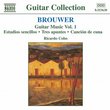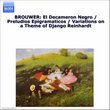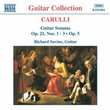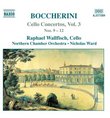| All Artists: Ferdinando Carulli, Massimo Palumbo (Fortepiano), Leopoldo Saracino (Guitar) Title: Ferdinando Carulli: Complete Works for Guitar & Fortepiano Members Wishing: 0 Total Copies: 0 Label: Brilliant Classics Original Release Date: 1/1/2006 Re-Release Date: 1/24/2006 Album Type: Box set, Import Genres: Jazz, Special Interest, Classical Styles: Swing Jazz, Marches, Chamber Music, Historical Periods, Classical (c.1770-1830), Instruments, Strings Number of Discs: 8 SwapaCD Credits: 8 UPC: 675754780722 |
Search - Ferdinando Carulli, Massimo Palumbo (Fortepiano), Leopoldo Saracino (Guitar) :: Ferdinando Carulli: Complete Works for Guitar & Fortepiano
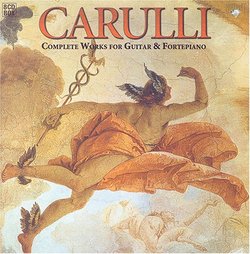 | Ferdinando Carulli, Massimo Palumbo (Fortepiano), Leopoldo Saracino (Guitar) Ferdinando Carulli: Complete Works for Guitar & Fortepiano Genres: Jazz, Special Interest, Classical
|
Larger Image |
CD DetailsSimilar CDs |
CD ReviewsMelodious, Entertaining, Congenial Leslie Richford | Selsingen, Lower Saxony | 04/05/2008 (4 out of 5 stars) "Ferdinando Carulli (1770 - 1841): Complete Works for Guitar and Fortepiano. Performed by Massimo Palumbo (Fortepiano by Felix Gross, Vienna 1812) and Leopoldo Saracino (Six-stringed guitar by Gaetano Guadagnini 1820). Recorded some time during the early 1990's in the Assunta Church, Milan, Italy. [Brilliant Classics claims that the recordings were made in August 2002; that cannot be correct, because this is a licensed re-issue of 8 full-price CDs which originally appeared in the 90's on the Italian Nuova Era label in their series "Ancient Music"; my attention was first drawn to these recordings because the seventh CD in the series was awarded "Disc of the Month" status by a German Early Music magazine some time during the early 90's.] Re-issued at budget price as Brilliant Classics 92269/1-8. Total playing time: approx. 8 hrs. 10 min. Although not very well-known today, Ferdinando Carulli belonged, in his heyday, to the leading guitarists, to be named in one breath together with Mauro Giuliani, Anton Diabelli or Johann Kaspar Mertz. He was born in Naples, Italy, but moved as a young man to Paris, where he celebrated many a triumph as a saloon musician. He published many works both for solo guitar and for diverse combinations of instruments, including the works collected here for guitar and fortepiano. Carulli wrote and distributed these either alone or in co-operation with his son Gustavo. The period of his stay in Paris was the heyday of belcanto opera, and it is perhaps not surprising that many of the compositions played here reflect the highly popular opera melodies of Rossini, some simply being congenial transcriptions. CDs 5 and 6 contain Carulli's versions of 12 overtures from Rossini's operas, including such "hits" as "La Gazza Ladra" or "Semiramide". In addition to this, there is re-worked music or variations on pieces by Beethoven, Agthe, Ries, Auber - and Rossini again! Apart from the felicitous, highly entertaining melodies, these pieces could be characterized as ones in which the guitar does not play a minor role, as was common at the time, but instead concertizes with the fortepiano: In many of the pieces to be heard here, the guitar alternates with the fortepiano in playing the main melody. This combination of instruments would presumably be rather unattractive on modern instruments, and for this reason the two Italian musicians have decided to use period instruments. The fortepiano by Felix Gross played here sounds very clear despite its age, being, as one might expect, softer than a modern piano. Massimo Palumbo occasionally treats his instrument anything but gently, which, on some of the earlier CDs, leads now and then to balance problems - although this might have been caused by the uncertainty of the sound engineer who obviously experimented around somewhat, until achieving an absolutely glorious sound on the last two CDs, a sound which is so good that when listening you tend to forget the doubts you may have had on the previous ones. CD's 7 and 8 are real pearls and justify the price of the whole box - in fact, I would suggest considering these two CDs as worth the price of the whole and then thanking Brilliant Classics for giving away the other 6 CDs in the box! At all events, the box is worth being discovered, by guitarists first of all, but also by lovers of early 19th century instruments. - There is only one drop of wormwood: The very informative accompanying notes by Mario Torta and Leopoldo Saracino (in English translation only) are full of gross printing errors. The individual CDs come in printed cardboard sleeves." Could've been better. Robin Ray | Seattle, WA USA | 06/08/2009 (4 out of 5 stars) "Leslie Richford wrote a great review of this collection. I have nothing against the performances, but the sound irks me a little. The guitar sounds fine - it's the fortepiano that gets under my skin at times. A handful of keys are out of tune, and it was mic'd and recorded in such a narrow way that the piano sounds like one of those uprights languishing away, forgotten, in the basement of a school, church, or nursing home. Also, because of the heavier reverb employed on the piano, it doesn't blend well with the relatively dry and up-front recording of the guitar. It almost sounds as if the two musicians were in separate rooms. Carulli's work, though miniaturistic, is still majestic in scope. a Bosendorfer, Yamaha, or Steinway would not have been an insult to him. In fact, I'm quite certain, he would've worn an ear to ear smile."
|

 Track Listings (15) - Disc #1
Track Listings (15) - Disc #1